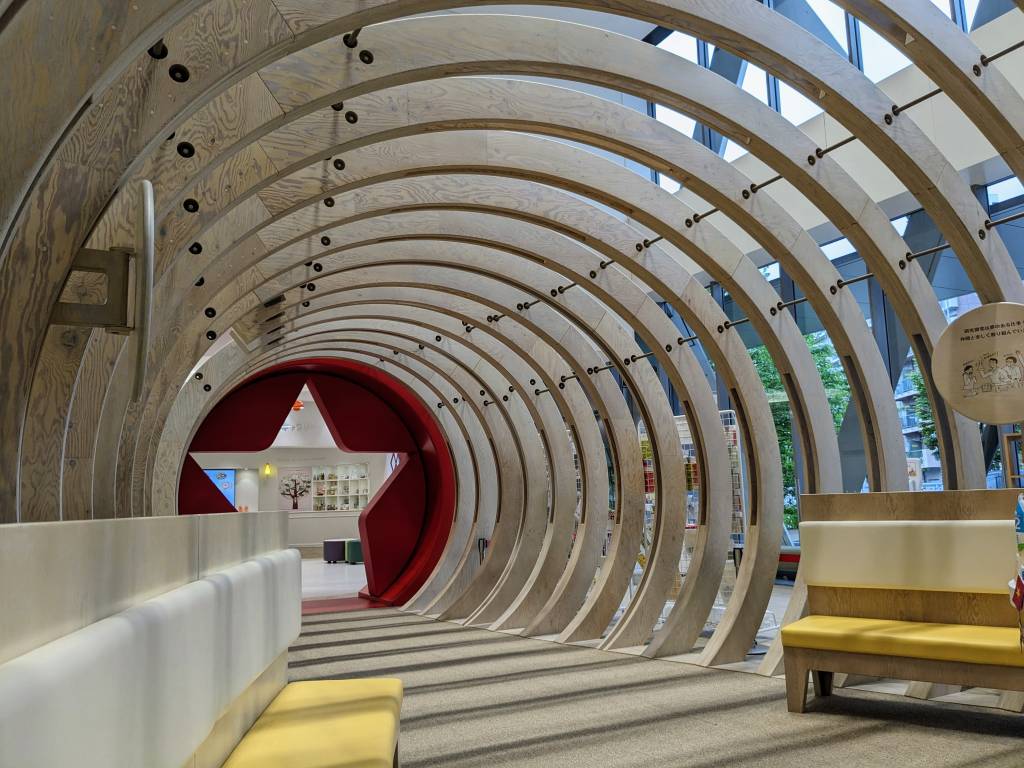Get ready to step into a world of wonders with the reopening of teamLab Borderless: Mori Building Digital Art Museum.
The new teamLab Borderless opened in February, 2024, in Azabudai Hills, near Roppongi. With two never-before-seen exhibitions, plus old favorites, there’s a lot to see. Here’s everything you need to know about the new teamLab Borderless digital art museum in Tokyo.
What is teamLab Borderless?

Officially called teamLab Borderless: Mori Building Digital Art Museum, teamLab Borderless is considered the world’s first digital art museum. But don’t let that fool you — it’s unlike any museum you’ve ever seen. It uses hundreds of lights, projectors, and computers to create a truly immersive experience.
Curious about the other teamLab exhibitions across Japan? Check them all out in our dedicated Mega Guide. Also, take a look at the newest (and biggest) teamLab exhibition to come to Japan — teamLab Biovortex Kyoto.
The new teamLab Borderless in Azabudai Hills
teamLab Borderless reopened in February, 2024Tickets are available online

The teamLab Borderless museum comes complete with two never-before-seen exhibitions: “Bubble Universe” and “Megalith Crystal Formation”. For these alone, you’re definitely going to want to add the place to your must-see list.
In addition, you can look forward to crowdpleasers from the original Borderless, like the “waterfall feature”, as its colloquially known, and the “Sketch Ocean”.

Why did the first teamLab Borderless close?
The original teamLab Borderless museum opened in Odaiba in 2018. It quickly started drawing in the crowds, and continued to do so right up until it closed in 2022. It actually broke records as the most-visited museum in the world.
Unfortunately, redevelopment work at Odaiba Palette Town — the entertainment complex that housed Borderless — forced the closure. Luckily for us, they were able to find their new home in Azabudai Hills.
What is teamLab Borderless like?

teamLab Borderless is a “museum without a map”. Neither visitors nor the artworks are confined to strict boundaries — the art is constantly in motion. You can experience a change of scenery — a burst of purple flowers here, a shower of sunflowers there — without moving a muscle. It isn’t called “Borderless” for nothing.
The Mori Building Digital Art Museum’s stunning installations make the perfect backdrop for #aesthetic shots. But don’t just visit for the Instagram potential. You’re encouraged to experience the art in ways other than clicking away on your phone. After all, it’s been said that all art is immersive, and you can truly feel that here. For one, some art projections react to touch.
Pro tip: Azabudai Hills is a great place to explore after you visit the museum. There’s plenty to see and do, including some of the best dining options in Tokyo.
Must-try: Chill out in the Mori Digital Art Museum’s En Tea House

If you get tired after exploring the museum, you can unwind with a cup of tea at En Tea House. Yes, this digital art museum really is an experience for all the senses. Digital flowers bloom in your cup, and will keep blooming while there’s still tea inside.
Where to buy tickets for teamLab Borderless
Tickets for the new teamLab Borderless are priced as follows: An adult (18 and over) ticket costs ¥3,800–¥4,800, while tickets for those aged 13 to 17 cost ¥2,800, and tickets for children aged 4 to 12 cost ¥1,500. People with disability certificates can get tickets for ¥1,900–¥2,400. Children under 3 are free. Adult prices fluctuate depending on the day and season.
teamLab Borderless tickets are available on Klook and the official teamLab website. We recommend buying your tickets for teamLab Borderless at least 2 or 3 weeks in advance to avoid disappointment.
Tips for planning your visit to teamLab Borderless in Tokyo

Here’s how to ensure you have the best experience at teamLab Borderless:
- Buy your tickets as far in advance as you can, to ensure you get your prefered day and timeslot.
- To avoid crowds, we recommend booking your tickets for the earliest timeslot on a weekday.
- Some rooms have mirrors on the floor, so wearing skirts or dresses is not recommended.
- Take lots of photos and videos, but immerse yourself in the experience as well.
- Allow yourself lots of time. While tickets have a set date and time, you can remain in the museum for as long as you like, so don’t worry about rushing through!
- Download the teamLab app before your visit. You can use the app to learn about the concepts behind the artworks and get numbered tickets for Infinite Crystal World.
- Give yourself time to double back and see areas for a second time. Many of the artworks change over time, so you’ll have a chance to see something new.
What exactly is the teamLab art collective?
teamLab is a digital art collective comprising international artists, scientists, and more. It was co-founded in 2001 by Toshiyuki Inoko and four friends. They started out with website and storefront designs, and in 2011 were invited by the well-known Japanese artist Takashi Murakami to make their debut at the Singapore Biennale contemporary art exhibition. From there, their popularity grew.
They had multiple exhibitions around the world before organizing their own exhibition in Tokyo in 2015. But it was only in 2018 that teamLab finally launched permanent (or, at least, long-term) exhibitions in Tokyo. Better late than never, we suppose.
There are now two teamLab digital art museums in Tokyo — teamLab Borderless and teamLab Planets.
teamLab isn’t just a Tokyo thing though, there’s teamLab Botanical Garden in Osaka, teamLab Forest in Fukuoka, and teamLab Acorn Forest in Saitama. Plus, there are temporary events too like teamLab: Digitized Fukuyama Castle in Fukuyama and teamLab: A Forest Where Gods Live at Takeo Onsen in Kyūshū.
Other digital art museums and galleries in Tokyo

If you’ve missed teamLab Borderless, not to worry, teamLab Planets is a worthy alternative. What’s the difference between the two? TeamLab Planets has similar installations to teamLab Borderless, but is a more tactile experience. For example, visitors can wade through the water of a digital koi pond.
There are also some wonderful hidden sound, art, and poetry experiences to check out, and the Zukan Museum in Ginza. And, you can always check out the popular 3D animal billboards all around Tokyo:
- Cat billboard in Shinjuku
- Panda billboard in Shibuya
- Akita Inu billboard in Shibuya
- Owl billboard in Ikebukuro
- Town Musicians of Bremen in Harajuku
Also, forget any misconceptions about art being boring and stuffy. Check out our mega guide to Tokyo’s best museums for more fun ideas.
Frequently asked questions
Is Mori Building Digital Art Museum: teamLab Borderless worth it?
Yes, teamLab Borderless is very much worth it for anyone who likes pretty lights and immersive art. Would we go twice? Maybe not, but it’s a must-see while you’re in Japan.
Where is teamLab Borderless in Tokyo?
The new teamLab Borderless is in Azabudai Hills, a shopping and entertainment complex in Minato Ward. It’s about a 15-minute walk from either Roppongi Station or Azabujūban Station. Don’t get it mixed up with the old teamLab Borderless location in Odaiba, or the teamLab Planets museum in Toyosu, though.
How much is teamLab Borderless?
Entry tickets cost ¥3,800–¥4,800 for those aged 18 and over. Ticket prices fluctuate depending on the date. Children’s tickets range from ¥1,500 to ¥2,800, depending on their age. Children under 3 can enter for free.
How much time do you need for teamLab Borderless?
We’d recommend putting aside around 2 hours to fully appreciate teamLab Borderless. This might seem like a lot, but keep in mind that the displays are constantly moving and shifting, so you can spend a surprising amount of time just in one place.
Which is better: teamLab Borderless or teamLab Planets?
Ohh, tough question. To be honest, it depends on what kind of experience you want. teamLab Borderless was the OG and has moving, interactive displays. There’s no set route, so it also feels like you’re exploring — you can chase a floral kangaroo down a hallway if you want to. Meanwhile, teamLab Planets is more tactile and immersive — you’ll wade through water, climb over spongy floors, and listen to soft echoes. teamLab Planets also has more of a set route, and the displays are restricted to their respective rooms.
While we do our best to ensure it’s correct, information is subject to change. This post was first published in September 2018. Last updated in February 2024, by Maria Danuco.
閱讀繁體中文版本: 東京 teamLab Borderless:最新必看重點整合!



































